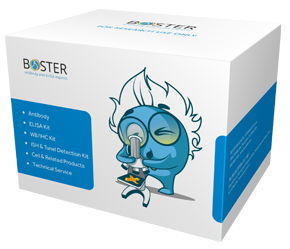Product Info Summary
| SKU: | A01131-1 |
|---|---|
| Size: | 100 μg/vial |
| Reactive Species: | Human, Mouse, Rat |
| Host: | Rabbit |
| Application: | Flow Cytometry, IHC, WB |
Customers Who Bought This Also Bought
Product info
Product Name
Anti-MEF2C Antibody Picoband®
SKU/Catalog Number
A01131-1
Size
100 μg/vial
Form
Lyophilized
Description
Boster Bio Anti-MEF2C Antibody Picoband® catalog # A01131-1. Tested in Flow Cytometry, IHC, WB applications. This antibody reacts with Human, Mouse, Rat. The brand Picoband indicates this is a premium antibody that guarantees superior quality, high affinity, and strong signals with minimal background in Western blot applications. Only our best-performing antibodies are designated as Picoband, ensuring unmatched performance.
Storage & Handling
Store at -20˚C for one year from date of receipt. After reconstitution, at 4˚C for one month. It can also be aliquotted and stored frozen at -20˚C for six months. Avoid repeated freeze-thaw cycles.
Cite This Product
Anti-MEF2C Antibody Picoband® (Boster Biological Technology, Pleasanton CA, USA, Catalog # A01131-1)
Host
Rabbit
Contents
Each vial contains 4mg Trehalose, 0.9mg NaCl, 0.2mg Na2HPO4, 0.05mg NaN3.
Clonality
Polyclonal
Isotype
Rabbit IgG
Immunogen
A synthetic peptide corresponding to a sequence at the C-terminus of human MEF2C, identical to the related mouse and rat sequences.
*Blocking peptide can be purchased. Costs vary based on immunogen length. Contact us for pricing.
Cross-reactivity
No cross-reactivity with other proteins.
Reactive Species
A01131-1 is reactive to MEF2C in Human, Mouse, Rat
Reconstitution
Add 0.2ml of distilled water will yield a concentration of 500ug/ml.
Observed Molecular Weight
50-65 kDa
Calculated molecular weight
51.221kDa
Background of MEF2C
MEF2C (myocyte enhancer factor 2C), also called MADS box transcription enhancer factor 2, polypeptide C, is a protein that in humans is encoded by the MEF2C gene. MEF2C is a transcription factor in the Mef2 family. MEF2C, however, is induced late during myogenic differentiation and has a strict tissue-specific pattern of expression not seen in MEF2A or MEF2B. By fluorescence in situ hybridization, the human MEF2C is mapped to chromosome 5q14, a region with homology of synteny to the mouse location.MEF2C may be involved with maintenance of the differentiated state. Both MEF2A and Mef2c programmed similar profiles of gene expression in the heart that included genes involved in extracellular matrix remodeling, ion handling, and metabolism. NCOA2 mediates the coactivation of MEF2C-dependent transcription through interaction with the MADS box domain of MEF2C.
Antibody Validation
Boster validates all antibodies on WB, IHC, ICC, Immunofluorescence, and ELISA with known positive control and negative samples to ensure specificity and high affinity, including thorough antibody incubations.
Application & Images
Applications
A01131-1 is guaranteed for Flow Cytometry, IHC, WB Boster Guarantee
Assay Dilutions Recommendation
The recommendations below provide a starting point for assay optimization. The actual working concentration varies and should be decided by the user.
Western blot, 0.25-0.5μg/ml, Human
Immunohistochemistry (Paraffin-embedded Section), 2-5μg/ml, Human, Mouse, Rat
Flow Cytometry (Fixed), 1-3μg/1x106 cells, Human
Positive Control
WB: human K562 whole cell, human COLO320 whole cell, human DAUDI whole cell, human U937 whole cell, rat brain tissue
IHC: human tonsil tissue, rat brain tissue, mouse brain tissue
FCM: HELA cell
Validation Images & Assay Conditions

Click image to see more details
Figure 1. Western blot analysis of MEF2C using anti-MEF2C antibody (A01131-1).
Electrophoresis was performed on a 5-20% SDS-PAGE gel at 70V (Stacking gel) / 90V (Resolving gel) for 2-3 hours. The sample well of each lane was loaded with 50ug of sample under reducing conditions.
Lane 1: human K562 whole cell lysates,
Lane 2: human COLO320 whole cell lysates,
Lane 3: human DAUDI whole cell lysates,
Lane 4: human U937 whole cell lysates,
Lane 5: rat brain tissue lysates.
After Electrophoresis, proteins were transferred to a Nitrocellulose membrane at 150mA for 50-90 minutes. Blocked the membrane with 5% Non-fat Milk/ TBS for 1.5 hour at RT. The membrane was incubated with rabbit anti-MEF2C antigen affinity purified polyclonal antibody (Catalog # A01131-1) at 0.5 μg/mL overnight at 4°C, then washed with TBS-0.1%Tween 3 times with 5 minutes each and probed with a goat anti-rabbit IgG-HRP secondary antibody at a dilution of 1:5000 for 1.5 hour at RT. The signal is developed using an Enhanced Chemiluminescent detection (ECL) kit (Catalog # EK1002) with Tanon 5200 system. A specific band was detected for MEF2C at approximately 50-65KD. The expected band size for MEF2C is at 50-65KD.
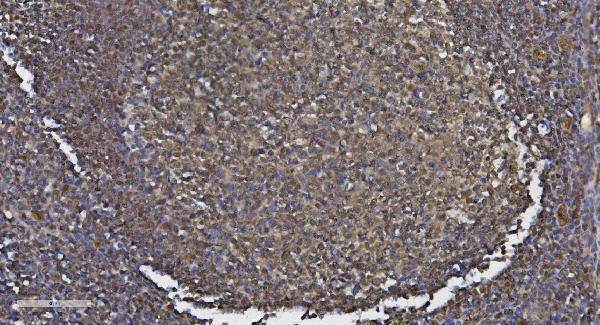
Click image to see more details
Figure 2. IHC analysis of MEF2C using anti-MEF2C antibody (A01131-1).
MEF2C was detected in paraffin-embedded section of human tonsil tissue. Heat mediated antigen retrieval was performed in EDTA buffer (pH8.0, epitope retrieval solution). The tissue section was blocked with 10% goat serum. The tissue section was then incubated with 2μg/ml rabbit anti-MEF2C Antibody (A01131-1) overnight at 4°C. Biotinylated goat anti-rabbit IgG was used as secondary antibody and incubated for 30 minutes at 37°C. The tissue section was developed using Strepavidin-Biotin-Complex (SABC) (Catalog # SA1022) with DAB as the chromogen.
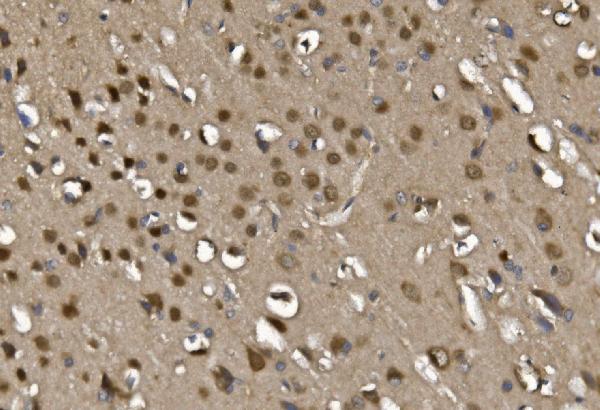
Click image to see more details
Figure 3. IHC analysis of MEF2C using anti-MEF2C antibody (A01131-1).
MEF2C was detected in paraffin-embedded section of rat brain tissue. Heat mediated antigen retrieval was performed in EDTA buffer (pH8.0, epitope retrieval solution). The tissue section was blocked with 10% goat serum. The tissue section was then incubated with 2μg/ml rabbit anti-MEF2C Antibody (A01131-1) overnight at 4°C. Biotinylated goat anti-rabbit IgG was used as secondary antibody and incubated for 30 minutes at 37°C. The tissue section was developed using Strepavidin-Biotin-Complex (SABC) (Catalog # SA1022) with DAB as the chromogen.
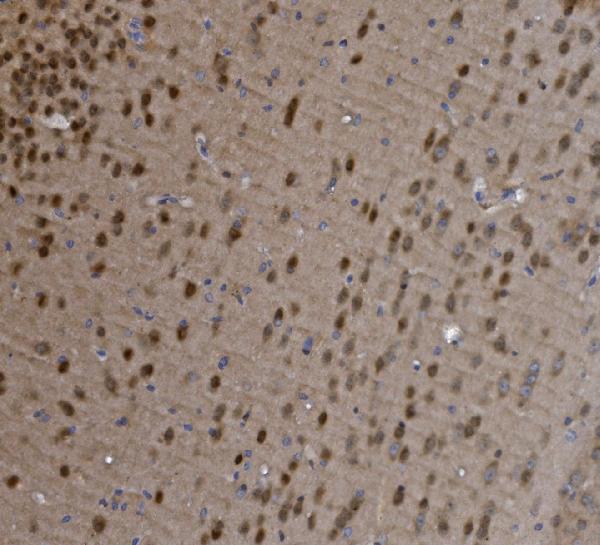
Click image to see more details
Figure 4. IHC analysis of MEF2C using anti-MEF2C antibody (A01131-1).
MEF2C was detected in paraffin-embedded section of mouse brain tissue. Heat mediated antigen retrieval was performed in EDTA buffer (pH8.0, epitope retrieval solution). The tissue section was blocked with 10% goat serum. The tissue section was then incubated with 2μg/ml rabbit anti-MEF2C Antibody (A01131-1) overnight at 4°C. Biotinylated goat anti-rabbit IgG was used as secondary antibody and incubated for 30 minutes at 37°C. The tissue section was developed using Strepavidin-Biotin-Complex (SABC) (Catalog # SA1022) with DAB as the chromogen.
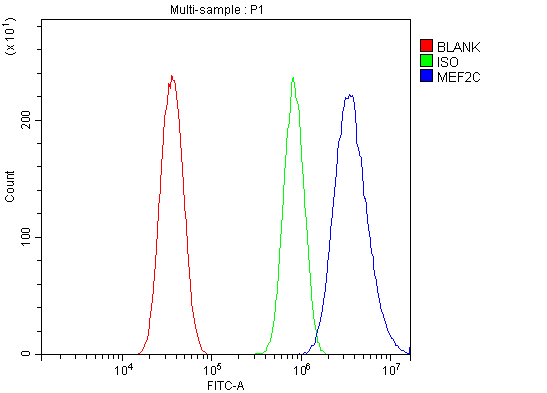
Click image to see more details
Figure 5. Flow Cytometry analysis of HELA cells using anti-MEF2C antibody (A01131-1).
Overlay histogram showing HELA cells stained with A01131-1 (Blue line). To facilitate intracellular staining, cells were fixed with 4% paraformaldehyde and permeabilized with permeabilization buffer. The cells were blocked with 10% normal goat serum. And then incubated with rabbit anti-MEF2C Antibody (A01131-1, 1μg/1x106 cells) for 30 min at 20°C. DyLight®488 conjugated goat anti-rabbit IgG (BA1127, 5-10μg/1x106 cells) was used as secondary antibody for 30 minutes at 20°C. Isotype control antibody (Green line) was rabbit IgG (1μg/1x106) used under the same conditions. Unlabelled sample without incubation with primary antibody and secondary antibody (Red line) was used as a blank control.
Protein Target Info & Infographic
Gene/Protein Information For MEF2C (Source: Uniprot.org, NCBI)
Gene Name
MEF2C
Full Name
Myocyte-specific enhancer factor 2C
Weight
51.221kDa
Superfamily
MEF2 family
Alternative Names
Myocyte-specific enhancer factor 2C ; Myocyte enhancer factor 2C MEF2C C5DELq14.3, DEL5q14.3 myocyte enhancer factor 2C myocyte-specific enhancer factor 2C|MADS box transcription enhancer factor 2, polypeptide C
*If product is indicated to react with multiple species, protein info is based on the gene entry specified above in "Species".For more info on MEF2C, check out the MEF2C Infographic

We have 30,000+ of these available, one for each gene! Check them out.
In this infographic, you will see the following information for MEF2C: database IDs, superfamily, protein function, synonyms, molecular weight, chromosomal locations, tissues of expression, subcellular locations, post-translational modifications, and related diseases, research areas & pathways. If you want to see more information included, or would like to contribute to it and be acknowledged, please contact [email protected].
Specific Publications For Anti-MEF2C Antibody Picoband® (A01131-1)
Hello CJ!
No publications found for A01131-1
*Do you have publications using this product? Share with us and receive a reward. Ask us for more details.
Recommended Resources
Here are featured tools and databases that you might find useful.
- Boster's Pathways Library
- Protein Databases
- Bioscience Research Protocol Resources
- Data Processing & Analysis Software
- Photo Editing Software
- Scientific Literature Resources
- Research Paper Management Tools
- Molecular Biology Software
- Primer Design Tools
- Bioinformatics Tools
- Phylogenetic Tree Analysis
Customer Reviews
Have you used Anti-MEF2C Antibody Picoband®?
Submit a review and receive an Amazon gift card.
- $30 for a review with an image
0 Reviews For Anti-MEF2C Antibody Picoband®
Customer Q&As
Have a question?
Find answers in Q&As, reviews.
Can't find your answer?
Submit your question
16 Customer Q&As for Anti-MEF2C Antibody Picoband®
Question
We want to test anti-MEF2C antibody A01131-1 on human fetal brain muscle for research purposes, then I may be interested in using anti-MEF2C antibody A01131-1 for diagnostic purposes as well. Is the antibody suitable for diagnostic purposes?
Verified Customer
Verified customer
Asked: 2020-02-05
Answer
The products we sell, including anti-MEF2C antibody A01131-1, are only intended for research use. They would not be suitable for use in diagnostic work. If you have the means to develop a product into diagnostic use, and are interested in collaborating with us and develop our product into an IVD product, please contact us for more discussions.
Boster Scientific Support
Answered: 2020-02-05
Question
My team were happy with the WB result of your anti-MEF2C antibody. However we have observed positive staining in fetal brain muscle nucleus. using this antibody. Is that expected? Could you tell me where is MEF2C supposed to be expressed?
Verified Customer
Verified customer
Asked: 2020-02-04
Answer
From what I have seen in literature, fetal brain muscle does express MEF2C. Generally MEF2C expresses in nucleus. Regarding which tissues have MEF2C expression, here are a few articles citing expression in various tissues:
Erythroleukemia, Pubmed ID: 23186163
Fetal brain, and Muscle, Pubmed ID: 7679508
Skeletal muscle, Pubmed ID: 8455629, 17974005
Boster Scientific Support
Answered: 2020-02-04
Question
Our lab want to know about using your anti-MEF2C antibody for positive regulation of neuron differentiation studies. Has this antibody been tested with western blotting on kidney tissue? We would like to see some validation images before ordering.
Verified Customer
Verified customer
Asked: 2020-01-30
Answer
Thank you for your inquiry. This A01131-1 anti-MEF2C antibody is validated on rat lung tissue, brain tissue, mouse brain, cardiac muscle tissue, spleen tissue, kidney tissue, small intestine tissue. It is guaranteed to work for IHC, WB in human, mouse, rat. Our Boster guarantee will cover your intended experiment even if the sample type has not been be directly tested.
Boster Scientific Support
Answered: 2020-01-30
Question
I have a question about product A01131-1, anti-MEF2C antibody. I was wondering if it would be possible to conjugate this antibody with biotin. I would need it to be without BSA or sodium azide. I am planning on using a buffer exchange of sodium azide with PBS only. Would there be problems for me to conjugate the antibody and store it in -20 degrees in small aliquots?
Verified Customer
Verified customer
Asked: 2019-10-08
Answer
We suggest not storing this antibody with PBS buffer only in -20 degrees. If you want to store it in -20 degrees it is best to add some cryoprotectant like glycerol. If you want carrier free A01131-1 anti-MEF2C antibody, we can provide it to you in a special formula with trehalose and/or glycerol. These molecules will not interfere with conjugation chemistry and provide a good level of protection for the antibody from degradation. Please be sure to specify this in your purchase order.
Boster Scientific Support
Answered: 2019-10-08
Question
I appreciate helping with my inquiry over the phone. Here are the WB image, lot number and protocol we used for fetal brain muscle using anti-MEF2C antibody A01131-1. Let me know if you need anything else.
Verified Customer
Verified customer
Asked: 2019-09-02
Answer
I appreciate the data. You have provided everything we needed. Our lab team are working to resolve your inquiry as quickly as possible, and we appreciate your patience and understanding! Please let me know if there is anything you need in the meantime.
Boster Scientific Support
Answered: 2019-09-02
Question
I was wanting to use your anti-MEF2C antibody for IHC for human fetal brain muscle on frozen tissues, but I want to know if it has been validated for this particular application. Has this antibody been validated and is this antibody a good choice for human fetal brain muscle identification?
Verified Customer
Verified customer
Asked: 2019-08-07
Answer
You can see on the product datasheet, A01131-1 anti-MEF2C antibody has been validated for IHC, WB on human, mouse, rat tissues. We have an innovator award program that if you test this antibody and show it works in human fetal brain muscle in IHC-frozen, you can get your next antibody for free.
Boster Scientific Support
Answered: 2019-08-07
Question
Is there a BSA free version of anti-MEF2C antibody A01131-1 available?
Verified Customer
Verified customer
Asked: 2019-07-10
Answer
Thank you for your recent telephone inquiry. I can confirm that some lots of this anti-MEF2C antibody A01131-1 are BSA free. For now, these lots are available and we can make a BSA free formula for you free of charge. It will take 3 extra days to prepare. If you require this antibody BSA free again in future, please do not hesitate to contact me and I will be pleased to check which lots we have in stock that are BSA free.
Boster Scientific Support
Answered: 2019-07-10
Question
Is a blocking peptide available for product anti-MEF2C antibody (A01131-1)?
Verified Customer
Verified customer
Asked: 2019-06-19
Answer
We do provide the blocking peptide for product anti-MEF2C antibody (A01131-1). If you would like to place an order for it please contact [email protected] and make a special request.
Boster Scientific Support
Answered: 2019-06-19
Question
Will A01131-1 anti-MEF2C antibody work on parafin embedded sections? If so, which fixation method do you recommend we use (PFA, paraformaldehyde, other)?
Verified Customer
Verified customer
Asked: 2019-06-13
Answer
It shows on the product datasheet, A01131-1 anti-MEF2C antibody as been validated on IHC. It is best to use PFA for fixation because it has better tissue penetration ability. PFA needs to be prepared fresh before use. Long term stored PFA turns into formalin, as the PFA molecules congregate and become formalin.
Boster Scientific Support
Answered: 2019-06-13
Question
We are currently using anti-MEF2C antibody A01131-1 for rat tissue, and we are well pleased with the IHC results. The species of reactivity given in the datasheet says human, mouse, rat. Is it possible that the antibody can work on primate tissues as well?
Verified Customer
Verified customer
Asked: 2019-06-07
Answer
The anti-MEF2C antibody (A01131-1) has not been validated for cross reactivity specifically with primate tissues, though there is a good chance of cross reactivity. We have an innovator award program that if you test this antibody and show it works in primate you can get your next antibody for free. Please contact me if I can help you with anything.
Boster Scientific Support
Answered: 2019-06-07
Question
I see that the anti-MEF2C antibody A01131-1 works with IHC, what is the protocol used to produce the result images on the product page?
Verified Customer
Verified customer
Asked: 2019-05-31
Answer
You can find protocols for IHC on the "support/technical resources" section of our navigation menu. If you have any further questions, please send an email to [email protected]
Boster Scientific Support
Answered: 2019-05-31
Question
We purchased anti-MEF2C antibody for WB on skeletal muscle a few years ago. I am using human, and I plan to use the antibody for IHC next. I am interested in examining skeletal muscle as well as fetal brain muscle in our next experiment. Could give a recommendation on which antibody would work the best for IHC?
Verified Customer
Verified customer
Asked: 2018-02-27
Answer
I took a look at the website and datasheets of our anti-MEF2C antibody and I see that A01131-1 has been tested on human in both WB and IHC. Thus A01131-1 should work for your application. Our Boster satisfaction guarantee will cover this product for IHC in human even if the specific tissue type has not been validated. We do have a comprehensive range of products for IHC detection and you can check out our website bosterbio.com to find out more information about them.
Boster Scientific Support
Answered: 2018-02-27
Question
We have been able to see staining in rat skeletal muscle. Are there any suggestions? Is anti-MEF2C antibody supposed to stain skeletal muscle positively?
B. Thomas
Verified customer
Asked: 2016-10-06
Answer
From what I have seen in literature skeletal muscle does express MEF2C. From what I have seen in Uniprot.org, MEF2C is expressed in middle temporal gyrus, fetal brain muscle, skeletal muscle, erythroleukemia, among other tissues. Regarding which tissues have MEF2C expression, here are a few articles citing expression in various tissues:
Erythroleukemia, Pubmed ID: 23186163
Fetal brain, and Muscle, Pubmed ID: 7679508
Skeletal muscle, Pubmed ID: 8455629, 17974005
Boster Scientific Support
Answered: 2016-10-06
Question
See below the WB image, lot number and protocol we used for fetal brain muscle using anti-MEF2C antibody A01131-1. Please let me know if you require anything else.
A. Gonzalez
Verified customer
Asked: 2016-06-29
Answer
Thank you very much for the data. Our lab team are working to resolve this as quickly as possible, and we appreciate your patience and understanding! You have provided everything we needed. Please let me know if there is anything you need in the meantime.
Boster Scientific Support
Answered: 2016-06-29
Question
Would anti-MEF2C antibody A01131-1 work for IHC with fetal brain muscle?
C. Jones
Verified customer
Asked: 2014-04-17
Answer
According to the expression profile of fetal brain muscle, MEF2C is highly expressed in fetal brain muscle. So, it is likely that anti-MEF2C antibody A01131-1 will work for IHC with fetal brain muscle.
Boster Scientific Support
Answered: 2014-04-17
Question
Is this A01131-1 anti-MEF2C antibody reactive to the isotypes of MEF2C?
J. Jha
Verified customer
Asked: 2013-09-16
Answer
The immunogen of A01131-1 anti-MEF2C antibody is A synthetic peptide corresponding to a sequence of human MEF2C (DREDHRNE FHSPIGLTRPSPDERESPSVKRMRLSEGWAT). Could you tell me which isotype you are interested in so I can help see if the immunogen is part of this isotype?
Boster Scientific Support
Answered: 2013-09-16



